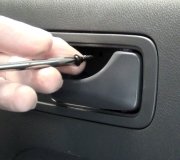This sounds like a 'check engine light" also known as a 'malfunction indicator light'. Unless you are into a bit of electronic diagnosis you are better to get this one seen to by a dealership. In short, the 98 Honda (like most cars today) has an onboard diagnostic system (OBD II) designed to monitor and detect emmisions system faults. The OBD consists of an on board computer known as the Powertrain Control Module or PCM, and information sensors which monitor various functions of the engine and send data back to the PCM. The PCM will illuminate the check engine light and store a fault code if it recognises a componet fault for two consecutive drive cycles. It will continue to set the light until the fault code is cleared.
The diagnostic codes can be extracted from the PCM using a 'jumper wire' technique which will cause the check engine light to flash a code. For example the light might flash 9 long flashes followed by one short flash thus indicating a code 91 fault. This particular code relates to a fuel tank pressure problem and could be as simple as making sure your fuel cap has been properly replaced after your last fill up. You should check your fuel cap anyway if only to eliminate this simple problem as a possible cause of your check engine light illumination. Chances are though that it will be something a little harder to diagnose (there are about 80 - 90 different codes) in which case you are best taking the car to a dealer where they have special scan tools which interface with the OBD system and can also clear the fault codes once the problem has been fixed.
With the above in mind, the check engine light can indicate sensor problems with O2, Manifold Absolute Pressure (MAP), electronic coolant temperature (ECT), throttle position sensors and VTEC or auto transaxle malfunctions to name just a few. This does not however necessarily mean the sensor is at fault. It may be something esle which is causing the sensor to send bad data to the PCM and thus illuminate the check engine light. So check the obvious things first like engine timing, loose, misfitting or cracked vacumn pipes and hoses, spark plugs and leads that may be causing misfiring, thermostat and coolant system for leaks etc. If something you do here fixes the problem, the PCM will need to see three consecutive drive cycles without any malfunction before it will clear the error code and turn off the check engine light.
In summary, unless you know the jumper wire technique and have a list of the codes, you are best to check for the simple things as explained above, and then drive for a few days to see if anything you did causes the check engine light to go out. If not, take it to your dealership. Hope this helps.
Tuesday, December 30th, 2008 AT 4:57 AM


